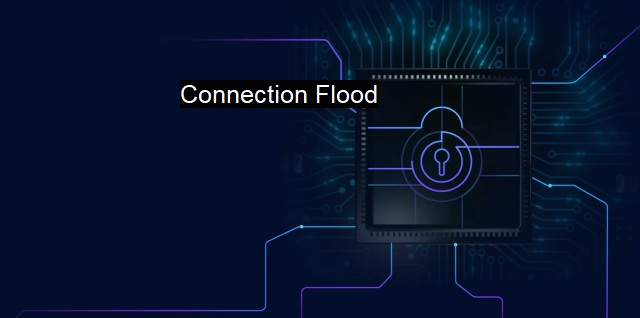What is Connection Flood?
Connection Flood: A Devastating Type of DDoS Attack that Paralyzes Networks and Disrupts User Experience
A term common amongst those experienced in the cyberworld, 'Connection Flood' is an increasingly widespread phenomenon in the realm of cybersecurity and antivirus. It refers to a type of Denial of Service (DoS) attack where numerous connections or data packets are inundated towards a unique network or service, seeking to disrupt its regular functions.Connection Flood invades the cyber infrastructure by inundating a system or network with so many connection requests that they exceed the target's capacity to respond, forcing it into a state of overload. This leaves the system incapable of processing legitimate requests and consequently disrupting its regular functioning or shutting it down entirely.
In a more elaborate context, connection flooding toys with the idea of an antagonist attacking the processing limits of a system, pool, or application with connection requests. The inexorable flow of requests overwhelms the system's resources, making it impractical to treat these connections appropriately or to undertake regular operations. The culminating effect is that the server becomes inaccessible to legitimate users.
One peculiar aspect of a Connection Flood attack is its ability to discreetly begin a DDoS attack, slowly overloading the server without drawing immediate attention towards it. Simply put, it's a quiet intrusion but tips the scale past the threshold when it is least expected.
A classic illustration of Connection Flood would be a Distributed Denial of Service or DDoS attack. A DDoS attack can be an illustration of a flood attack where multiple computer systems, compromised previously, are utilized to initiate traffic flow to a single target system, causing its downfall or them operating below normal efficiency. The rise of advances in automated applications and software has made initiating such attacks a rather uncomplicated process.
Devices connected to the internet such as a laptop, desktop, or even seemingly safe devices like smartphones can easily be deceived. Protection becomes complicated by unknowing users engaging with an untrusted source or downloading malicious software, inadvertently giving away their Internet's bandwidth to hackers who exploit these via computer Trojans collating bots to do their bidding.
This renders information from businesses, government entities, and even personal details of users open to mass scale data theft. It's not always immediately visible to the affected entity as many unauthorized activities including unauthorized access, end data breach, misuse of resources, or obvious signs of disturbance are cleverly kept under the radar till launch point.
It’s key to be proactive in cybersecurity crime prevention. Preference should always be given to automatic security updates, patches and one should regularly monitor suspicious activities or irregularities. Invest in comprehensive malware detection resources that combat not just known threats but those that evolve over time with varying derivatives.
The concept of secure scalable systems can inhibit flood attacks from insidiously impacting systems. Servers on an auto-scaling mode can mitigate sudden surges in traffic, switching to as many or as little resources as necessitated. Also, multi-factor authentication processes serve as an added layer of protection, verifying requests before actual connection setup.
In this era of hyper-connectivity, Connection Flood threats add further complexity. Cybersecurity teams must have a pulse in real-time of any cyber-nuisance happening in the network environment. Preemptive measures such as countermeasures built into existing systems to act against connection flood threats and response teams capacitated with training and technology to handle such instances form the backbone of an effective cybersecurity strategy.
While Connection Flood attacks may appear elusive, the disciplined dual approach of digital vigilance coupled with resilient infrastructure helps mitigate potentially devastating outcomes. This includes alertness to potential vulnerabilities, using sophisticated, layered protection measures, and continued improvement in tackling evolving threats is vital in maintaining cybersecurity health.

Connection Flood FAQs
What is connection flood in the context of cybersecurity?
Connection flood is a type of denial-of-service (DoS) attack where the attacker floods a target system with a huge number of connection requests, overwhelming its resources and making it unavailable to legitimate users.How does connection flood impact cybersecurity?
Connection flood can lead to a severe disruption of services and cause network downtime, which can result in financial losses and damage to reputation. Additionally, connection flood can be used as a distraction to divert attention away from other attacks.What are some methods to prevent connection flood attacks?
Some methods to prevent connection flood attacks include implementing rate limiting and traffic filtering mechanisms, deploying intrusion detection and prevention systems, and using load balancers to distribute traffic evenly. Additionally, ensuring that software and hardware systems are up-to-date with the latest patches and updates can help mitigate the risk of connection flood attacks.How can antivirus software help detect and prevent connection flood attacks?
Antivirus software can detect and prevent connection flood attacks by monitoring network traffic and identifying patterns of suspicious behavior. Additionally, antivirus software can block incoming traffic from known malicious IP addresses and prevent connections to known malicious domains. By detecting and blocking connection flood attacks, antivirus software can help protect against this type of cyber threat.| | A | | | B | | | C | | | D | | | E | | | F | | | G | | | H | | | I | | | J | | | K | | | L | | | M | |
| | N | | | O | | | P | | | Q | | | R | | | S | | | T | | | U | | | V | | | W | | | X | | | Y | | | Z | |
| | 1 | | | 2 | | | 3 | | | 4 | | | 7 | | | 8 | | |||||||